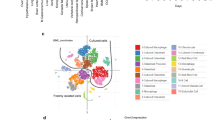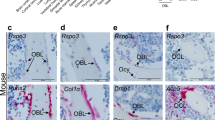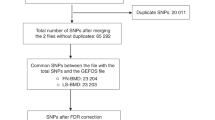Abstract
Osteoporosis is a common disease with a strong genetic component1–3, characterized by reduced bone mass and increased fracture risk4. Current evidence suggests that the inheritance of bone mass is under polygenic control5 but the genes responsible are poorly defined. Type I collagen is the major protein of bone encoded by the COLIA1 and COLIA2 genes. While these are strong candidates for the genetic regulation of bone mass, no abnormality of either gene has so far been defined in osteoporosis6. In this study, we describe a novel G→T polymorphism in a regulatory region of COLIA1 at a recognition site for the transcription factor Sp17 that is significantly related to bone mass and osteoporotic fracture. G/T heterozygotes at the polymorphic Sp1 site (Ss) had significantly lower bone mineral density (BMD) than G/G homozygotes (SS) in two populations of British women and BMD was lower still in T/T homozygotes (ss). The unfavourable Ss and ss genotypes were over-represented in patients with severe osteoporosis and vertebral fractures (54%), as compared with controls (27%), equivalent to a relative risk of 2.97 (95% confidence interval 1.63–9.56) for vertebral fracture in individuals who carry the ‘s’ allele. While the mechanisms that underlie this association remain to be defined, the COLIA1 Sp1 polymorphism appears to be an important marker for low bone mass and vertebral fracture, raising the possibility that genotyping at this site may be of value in identifying women who are at risk of osteoporosis.
This is a preview of subscription content, access via your institution
Access options
Subscribe to this journal
Receive 12 print issues and online access
$209.00 per year
only $17.42 per issue
Buy this article
- Purchase on SpringerLink
- Instant access to full article PDF
Prices may be subject to local taxes which are calculated during checkout
Similar content being viewed by others
References
Sorako, S.B., Barret-Connor, E., Edelstein, S.L. & Kritz-Silverstein, D. Family history of osteoporosis and bone mineral density at the axial skeleton: The Rancho Bernardo study. J. Bone Miner. Res. 9, 761–769 (1994).
Pocook, N.A., Eisman, J.A., Hopper, J.L., Yeates, M.G., Sambrook, P.N. & Eberl, S. Genetic determinants of bone mass in adults: a twin study. J. Clin. Invest. 80, 706–710 (1987).
Smith, D.M., Nance, W.E., Kang, K.W., Christian, J.C. & Johnston, C.C. Genetic factors in determining bone mass. J. Clin. Invest. 52, 2800–2808 (1973).
Kanis, J.A., Melton, L.J., Christiansen, C., Johnston, C.C. & Khaltaev, N. The diagnosis of osteoporosis. J. Bone Miner. Res. 9, 1137–1141 (1994).
Gueguen, R., Jouanny, P., guillemin, F. Kuntz, C., Pourel, J. & Siest, G. Segregation analysis and variance components analysis of bone mineral density in healthy families. J. Bone Miner. Res. 12, 2017–2022 (1995).
Spotila, L.D. et al. Mutation analysis of coding sequences for type I procollagen in individuals with low bone density. J. Bone Miner. Res. 9, 923–932 (1994).
Kadonga, J.T., Jones, K.A. & Tijan, R. Promoter-specific activation of RNA polymerase II transcription by Sp1. Trends Biochem. Sci. 11, 20–23 (1986).
Morrison, N.A. et al. Prediction of bone density from vitamin D receptor alleles. Nature 367, 284–287 (1994).
Spector, T.D. et al. Influence of vitamin D receptor genotype on bone mineral density in postmenopausal women: a twin study in Britain. Br. Med. J. 310, 1357–1360 (1995).
Peacock, M. Vitamin D receptor gene alleles and osteoporosis: a contrasting view. J. Bone Miner. Res. 10, 1294–1297 (1995).
Eisman, J.A. Vitamin D receptor gene alleles and osteoporosis: an affirmative view. J. BoneMiner. Res. 10, 1289–1293 (1995).
Mundy, G.R. Boning up on genes. Nature 367, 216–217 (1994).
Rowe, D.W. in Bone and Mineral Research (eds Heersche, J.N.M. & Kanis, J.A.) 209–241 (Elsevier, Amsterdam, 1991).
Sykes, B. Bone disease cracks genetics. Nature 348, 18–20 (1990).
Prockop, D.J. et al. Type I procollagen: The gene-protein system that harbors most of the mutations causing osteogenesis imperfecta and probably more common heritable disorders of connective tissue. Am. J. Hum. Genet. 34, 60–67 (1989).
Spotila, L.D., Constantinou, C.D., Sereda, L., Ganguly, A., Riggs, B.L. & Prockop, D.J. Mutation in the gene for type I procollagen (COL1A2) in a woman with postmenopausal osteoporosis: evidence for a phenotypic and genotypic overlap wrth mild osteogenesis imperfecta. Proc. Natl. Acad. Sci. USA 88, 5243–5427 (1991).
Chu, M.L., de Wet, W., Bernard, M. & Ramirez, F. Fine structural analysis of the human pro alpha-1 (l) collagen gene. J. Biol. Chem. 260, 2315–2320 (1985).
Rossouw, C.M.S., Vergeer, W.P., du Plooy, S.J., Bernard, M.P., Ramirez, F. & de Wet, W.J. DNA sequences in the first intron of the human pro-alpha-1 (I) collagen gene enhance transcription. J. Biol. Chem. 262, 15151–15157 (1987).
Seeman, E. et al. Reduced bone mass in daughters of women with osteoporosis. New Engl. J. Med. 320, 554–558 (1989).
Kobayashi, S., Inoue, S., Hosoi, T., Ouchi, Y., Shiraki, M. & Orimo, H. Association of bone minerai density with polymorphism of the estrogen receptor gene. J. Bone Miner. Res. 11, 306–311 (1996).
Keen, R.W., Woodford-Richens, K.L., Lanchbury, J.S. & Spector, T.D. Peak bone mass, early postmenopausal bone loss and polymorphism at the oestrogen receptor gene. Osteoporosis Int. 6, 102 (1996).
Qi, J.C. et al. Estrogen receptor genotypes and bone mineral density in women and men. J. Bone Miner. Res. 10, s170 (1995).
Uittertinden, A.G. et al. Sp1 binding site potymorphism in the COLIA1 gene is associated with BMD: the Rotterdam study. Osteoporosis Int. 6, 124 (1996).
Cooper, C. & Melton, L.J. Vertebral fractures. Br. Med. J. 304, 793–794 (1992).
Garton, M. et al. Bone mineral density and metabolism in premenopausal women taking thyroxine. Clin. Endocr. 41, 747–755 (1995).
Orita, M., Iwahana, H., Kanazana, H., Hayashi, K. & Sekiya, T. Detection of polymorphisms of human DNA by gel electrophoresis as single stranded conformational polymorphisms. Proc. Nati. Acad. Sci. USA 86, 2766–2770 (1993).
Chodosh, L.A. in Short Protocols in Molecular Biology Vol. 2 (eds Ausubel, F.M. et al.) 12-5–12-8 (Wiley, New York, 1992).
Andrews, N.A. & Faller, D.V. A rapid micropreparation technique for extraction of DNA-binding proteins from limited numbers of mamalian cells. Nucl. Acids Res. 19, 2499 (1991).
Meyer, M., Schreck, R. & Baeuerte, P.A. H2O2 and antioxidants have opposite effects on activation of NF-kB and AP-1 in intact cells: AP-1 as a secondary antioxidant-responsive factor. EMBO J. 12, 2005–2015 (1993).
Author information
Authors and Affiliations
Rights and permissions
About this article
Cite this article
Grant, S., Reid, D., Blake, G. et al. Reduced bone density and osteoporosis associated with a polymorphic Sp1 binding site in the collagen type I α 1 gene. Nat Genet 14, 203–205 (1996). https://doi.org/10.1038/ng1096-203
Received:
Accepted:
Issue Date:
DOI: https://doi.org/10.1038/ng1096-203
This article is cited by
-
Causal associations of brain structure with bone mineral density: a large-scale genetic correlation study
Bone Research (2023)
-
Association of osteoporosis and sarcopenia with fracture risk in transfusion-dependent thalassemia
Scientific Reports (2023)
-
Genetics of otosclerosis: finally catching up with other complex traits?
Human Genetics (2022)
-
Osteoporosis and its Association with Vitamin D Receptor, Oestrogen α Receptor, Parathyroid Receptor and Collagen Type I alpha Receptor Gene Polymorphisms with Bone Mineral Density: A Pilot Study from South Indian Postmenopausal Women of Tamil Nadu
Biochemical Genetics (2022)
-
Association between polymorphisms of collagen genes and susceptibility to intervertebral disc degeneration: a meta-analysis
Journal of Orthopaedic Surgery and Research (2021)



